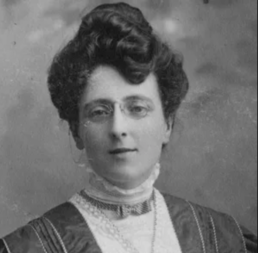These life stories may contain descriptions of childhood trauma and abuse, as well as images, voices and names of people now deceased. If you need help, you can find contact details for some relevant support services on our support page.
Significant Canadian writer, Lucy Maud Montgomery (1874-1942), was in kinship care as a child.
Lucy Maud Montgomery was born in Clifton, Prince Edward Island, Canada to Clara Woolner Macneill and Hugh John Montgomery.
It was from my mother’s family – the Macneills – that I inherited my knack of writing and my literary tastes. John Macneill had come to Prince Edward Island in 1775…(Montgomery).
Maud was only twenty-one months old when her mother died. Her father left her with her maternal grandparents, Lucy and Alexander Macneill, who lived in Cavendish on “the old Macneill Homestead” (Montgomery).
Alexander Macneil was both a farmer and orchardist and served his community as postmaster. He was stern, domineering and irritable. Lucy Macneil was cold, reserved and narrow in her affections. Still, in their own way, they loved Maud and folded her into their lives as an inconvenience to be endured (Sauerwein, 12).
Hugh Montgomery moved to Prince Albert, Saskatchewan when Maud was about seven and remarried in 1887.
Often on her own, Maud taught herself to read by the age of four and made do with broken dolls and farmyard cats for company. She felt she was a “charity case” and therefore inadequate; her grandparents’ “attitude stoked an anger in Maud and a need to prove herself. She developed a fierce independence and steely core of will” (Sauerwein, 15).
From the age of six, Maud attended the local Cavendish school.
When she was seven, the Macneil’s took in two boys, “Wellington and David Nelson, better known as “Well” and “Dave.” The Nelson boys were in kinship care with an aunt, but “because they lived too far from school for daily travel, their aunt paid the Macneills to take them in for three school years” (Sauerwein, 22).
Well was just my age, Dave a year younger. They were my playmates for three happy years; we did have fun in abundance, simple, wholesome, delightful fun, with our playhouses and our games in the beautiful summer twilights, when we ranged happily through fields and orchards, or in the in long winter evenings by the fire (Montgomery, emphasis in the original).
By the age of nine, Maud had developed a desire to “express herself in verse” (Sauerwein, 23) and when she was twelve she sent off her first poem. Although the poem was rejected and Maud’s spirits were dampened for a year, she thereafter continued sending out poems and stories, “and watched as manuscript after manuscript was returned, rejected” (Sauerwein, 25).
She continued anyway, creating stories and poems of all kinds, from tragic odes of death to fanciful tales of fairies. For practice, she rewrote her favourite novels, changing the plots to put the heroines in control of their destiny (Sauerwein, 25).
Just before Maud turned sixteen, her paternal grandfather, Donald Montgomery, took her to visit her father in Prince Albert. Maud and Hugh’s wife, Mary Ann, did not get along well but she did stay on and attend the Prince Albert school.
Maud completed her schooling back in Cavendish and then headed out to Prince of Wales College in Charlottetown to study to become a teacher. In 1894 she accepted a position at Bideford and nurtured her dream of becoming a writer by getting up early to compose stories.
In 1895 Maud began attending Dalhousie University in Halifax, Nova Scotia to study English Literature. It was during her time there that she first received payment for her writing.
The work for which Lucy Maud Montgomery is best known, Anne of Green Gables, was published in 1908, and immediately became a bestseller.
Maud, who had been writing in obscurity for years, suddenly had fans. Mark Twain sent her a letter describing Anne as “the dearest, and most loveable child in fiction since the immortal Alice” (Sauerwein, 70).
Montgomery wrote numerous poems, short stories, serials, and books and all but one of her twenty books are set on Prince Edward Island, the home she loved so much.
After Montgomery married Ewan MacDonald, a clergyman, in 1911, the couple lived in the vicarage of St Paul’s Presbyterian Church in Leaksdale, Ontario where their three sons were born. The family moved to Norval and another parish in 1927. When MacDonald’s career ended in 1935, Maud and Ewan moved to Toronto.
Lucy Maud Montgomery was the recipient of many awards including being honoured as an Officer of the Order of the British Empire (OBE) in 1923. In Canada, her homes in Leaskdale and on Prince Edward Island are recognised as historic sites, and stamps were issued in 2008 by Canada Post to mark the centennial of the publication of Anne of Green Gables.
References:
“About L. M. Montgomery”. L.M.Montgomery Institute, University of Prince Edward Island. https://lmmontgomery.ca/about/lmm/her-life
L.M. Mongomery Institute. University of Prince Edward Island. https://lmmontgomery.ca//about/lmm/her-life
Montgomery, L.M. The Alpine Path: The Story of My Career. A Celebration of Women Writers. https://digital.library.upenn.edu/women/montgomery/alpine/alpine.html
Rosenberg, Liz. The Life of L.M. Montgomery. Somerville, Massachusetts: Candlewick Press, 2018. https://www.candlewick.com/book_files/0763660574.chp.1.pdf
Sauerwein, Stan. Lucy Maud Mongomery. Canada’s Literary Treasure. Formac Publishing, 2020.
Image available here.
